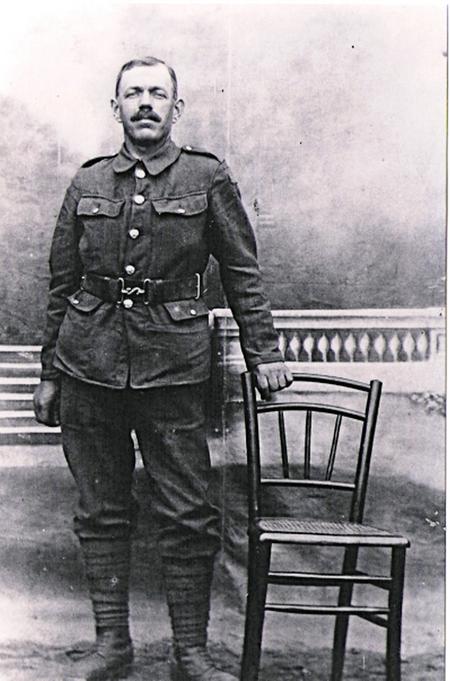Pte
Dixon Overfield
Information about birth
|
Date of birth: 10/10/1883 |
|
Place of birth: Filey, Yorkshire, England, United Kingdom |
General information
|
Last known residence: 5 Carlton Road, Filey, Yorkshire, England, United Kingdom |
|
Profession: Market Gardener |
|
Religion: Methodist |
Army information
|
Country: England, United Kingdom |
|
Force: British Expeditionary Force |
|
Rank: Private |
|
Service number: 41782 |
|
Enlistment date: 01/10/1916 |
|
Enlistment place: Filey, Yorkshire, England, United Kingdom |
|
Units: — Alexandra Princess of Wales's Own (Yorkshire Regiment), 6th Bn. (Last known unit) |
Information about death
|
Date of death: 09/10/1917 |
|
Place of death: Poelcapelle, Belgium |
|
Cause of death: Killed in action (K.I.A.) |
|
Age: 33 |
Memorial
|
Tyne Cot Memorial Panel: 53 A |
Distinctions and medals 2
|
British War Medal Medal |
|
Victory Medal Medal |
Points of interest 4
| #1 | Place of birth | ||
| #2 | Last known residence | ||
| #3 | Enlistment place | ||
| #4 | Place of death (approximate) |
My story
Dixon Overfield was born the 10th October 1883 in Filey, Yorkshire. He married Margaret Louise Dale at Folkton 4th August 1914. The newly married couple moved into a modern terraced house, 5 Carlton Road, Filey. Dixon earned his living from running a small holding in Filey. They had a daughter Madge Elizabeth Overfield.
Prior to his enlistment Dixon was a market gardener, a trustee of Muston chapel, a local preacher and Sunday school superintendent. Dixon was initially exempt from military service on the grounds of ‘family hardship’, but his certificate expired in September 1916.
Dixon was conscripted in October 1916 and was taken on by “D” Company of the 6th Battalion Yorkshire Regiment (Green Howards) which was part of the 32nd Brigade, 11th (North) Division.
In early October 1917 Dixon’s Battalion was involved in the Battle of Passchendaele.
On the 7th of October the 6th Yorkshires moved into the line. The relief was not completed till 3.40 am on the 8th October. On the 9th of October 1917 the 6th Yorkshires advanced at Zero Hour, 05.20 a.m. Advancing to the north of Poelcapelle, the Green Howards initially met little resistance, but on nearing the fork in the road opposite the Brewery they came under fire from Meunier House and from the direction of String Houses. Heavy German resistance forced, the battalion to dig in at 8 a.m. Whilst attempting to dig in, the battalion suffered heavy casualties from machine gun and rifle fire from both flanks. The Trench mortars that were attached to the battalion had all been knocked out by the German artillery, and the supporting tanks had become bogged down.
Dixon Overfield was killed on 9 October 1917, a day short his 34th Birthday. His remains weren’t identified and Dixon is remembered on the Tyne Cot Memorial.
Prior to his enlistment Dixon was a market gardener, a trustee of Muston chapel, a local preacher and Sunday school superintendent. Dixon was initially exempt from military service on the grounds of ‘family hardship’, but his certificate expired in September 1916.
Dixon was conscripted in October 1916 and was taken on by “D” Company of the 6th Battalion Yorkshire Regiment (Green Howards) which was part of the 32nd Brigade, 11th (North) Division.
In early October 1917 Dixon’s Battalion was involved in the Battle of Passchendaele.
On the 7th of October the 6th Yorkshires moved into the line. The relief was not completed till 3.40 am on the 8th October. On the 9th of October 1917 the 6th Yorkshires advanced at Zero Hour, 05.20 a.m. Advancing to the north of Poelcapelle, the Green Howards initially met little resistance, but on nearing the fork in the road opposite the Brewery they came under fire from Meunier House and from the direction of String Houses. Heavy German resistance forced, the battalion to dig in at 8 a.m. Whilst attempting to dig in, the battalion suffered heavy casualties from machine gun and rifle fire from both flanks. The Trench mortars that were attached to the battalion had all been knocked out by the German artillery, and the supporting tanks had become bogged down.
Dixon Overfield was killed on 9 October 1917, a day short his 34th Birthday. His remains weren’t identified and Dixon is remembered on the Tyne Cot Memorial.
Sources 3
|
6 Battalion Yorkshire Regiment, (The National Archives, KEW (TNA), WO 95/1809/4). https://discovery.nationalarchives.gov.uk/details/r/C14303 Sources used |
|
Census Returns of England and Wales, 1911 (The National Archives, Kew (TNA), RG14). https://www.nationalarchives.gov.uk/ Sources used |
|
McCarthy, Chris. Passchendaele, The Third Ypres: The Day-by-Day Account. (Londen: Unicorn Publishing Group, 2018), 124-125. Sources used |
More information 3
|
Commonwealth War Graves Commission Database https://www.cwgc.org/find-records/find-war-dead/casualty-details/1635794 |
|
Namenlijst (In Flanders Fields Museum) https://namenlijst.org/publicsearch/#/person/_id=b6b837d7-35bd-40fd-8284-fc02eb82a189 |
|
Lives of the First World War (Imperial War Museum) https://livesofthefirstworldwar.iwm.org.uk/lifestory/3349362 |
